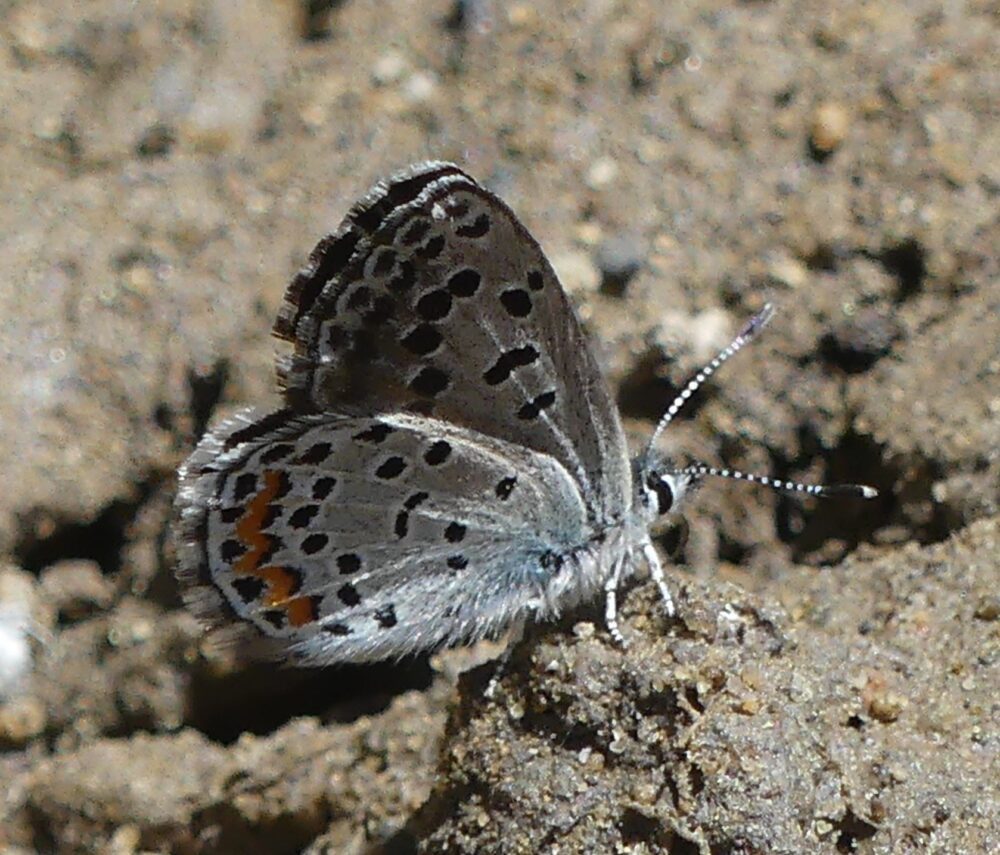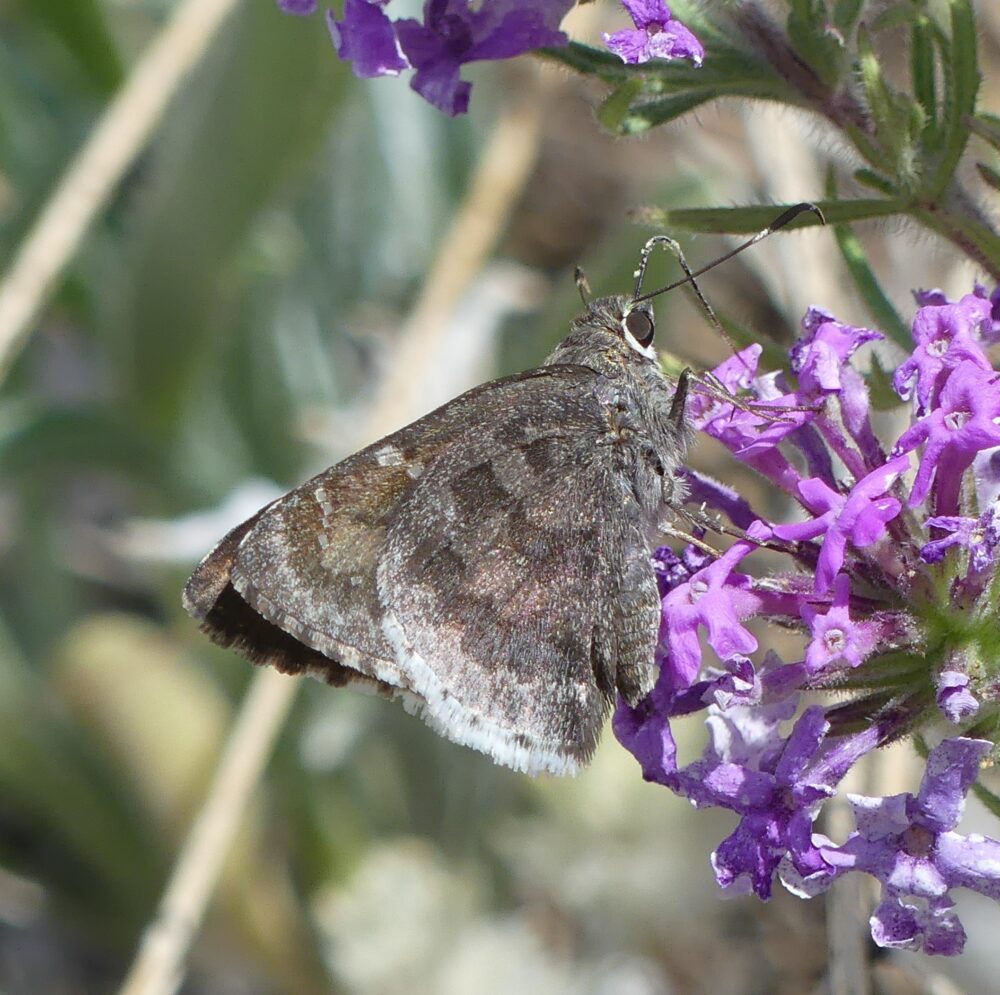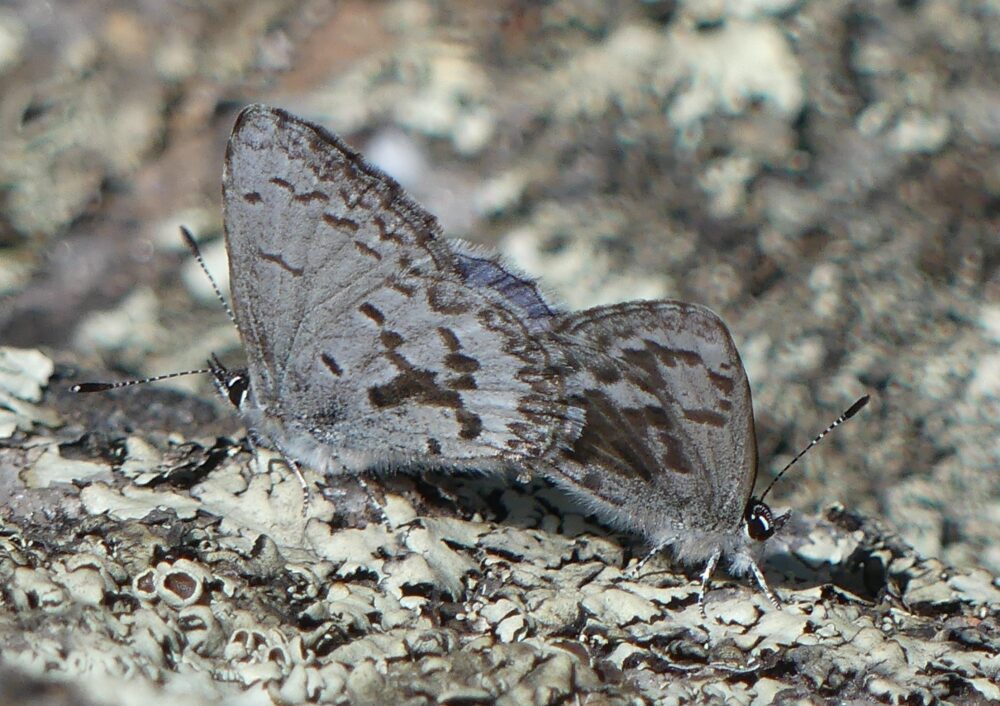© Steve Cary; February 2, 2024
A lot of good butterfly stuff happened in 2023, thanks in large part to your efforts. Last month we celebrated Jeff Glassberg’s discovery of White-tufted Sootywing (Pholisora albicirrus), which is a new member of New Mexico’s butterfly fauna. Other naturalists generated two additional New Mexico state record butterflies in 2023. Observations for each were made public via iNaturalist and each provoked a substantial online conversation about the correct identity and the significance of the observation. Read on for details.
An observation of Violet-clouded Skipper (Lerodea arabus) in Grant County, NM, can be viewed here (iNat 136383841). First posted on September 24, 2022, it promptly attracted the attention of skipper wizard Andy Warren. Was it Lerodea arabus or the very similar Lerema accius? The latter species has been documented in New Mexico before, though only rarely. Violet-clouded Skipper is known from southeast Arizona and I have seen it in far south Texas, but it had not yet been reported from our state. A productive back-and-forth ensued between commenters and the submitter, who was able to offer some additional information to support his ID. The conversation went on episodically for several months and finally in May 2023 a consensus was finally achieved. We added Violet-clouded Skipper to the New Mexico butterfly fauna: Butterflies of New Mexico: The Skippers VI: Folded-Wing Skippers (Hesperiidae: Hesperiinae) – Pajarito Environmental Education Center (peecnature.org). Because its caterpillars are willing to eat Bermudagrass (Cynodon dactylon), a routine lawn grass in southern latitudes, it is perhaps not surprising that Violet-clouded Skipper has become naturalized in Tucson, AZ, and is a regular sight there (Bailowitz and Brock 2021: 293). Intrigued New Mexico butterflyers might have some luck looking for it in urban lawn areas along our I-10 corridor.
Then in October 2023, Christopher Rustay and Mike Shoop visited hallowed Guadalupe Canyon in the southwest corner of our southwestern-most county. A highlight from that adventure was their posting of a tiny metalmark (iNat 187739281 and iNat 187795137). My own quick glance, kneejerk reaction would have been to call it Palmer’s Metalmark because it can be so routine in that area. Lucky for me, I did not have a chance to offer the wrong ID. Right after the image was posted, a knowledgeable commenter immediately saw that it might be Hepburn’s Metalmark (Apodemia hepburni), a very close relative of Palmer’s, and steered it to me for a look. I have never seen this species but knowing that a potential state record species was involved, I and others dug into the diagnostic details. Allowing for some ordinary wear on the wings, we came to a consensus that it was indeed Hepburn’s Metalmark. That individual had to be a rare stray from Mexico, but it made it to New Mexico so we are definitely welcoming it as a new member of our state’s fauna: Butterflies of New Mexico: The Metalmarks (Riodinidae) – Pajarito Environmental Education Center (peecnature.org).

New Mexico also tallied twenty (20) new county records in 2023. Three new records for Otero County exceeded totals for all other counties: Apache Skipper (kudos to Melissa LaFerriere), Fatal Metalmark (kudos iNat 174896096), and ‘Southwestern’ Black Swallowtail (kudos to Marta Reece). Three is a large number considering the healthy tally of butterfly species already known from Otero County (about 150 if I recall correctly). Historically though, most butterflying there has focused on the rich, productive (and comfortable in summer) high country. I believe several more “new” species for the county lurk in the xeric hill and mesa terrain that lies between the desert floor of the Tularosa Basin and the lushly forested ridges of the higher Sacramento Mountains. Please keep looking!
Also among the county records were three new counties for Indra Swallowtail (Papilio indra): Los Alamos, Rio Arriba and Santa Fe. I have commented on this butterfly before, but corroboration of the July observation in Santa Fe (iNat 194236174) further solidifies Indra as a widespread breeding resident in north-central New Mexico: Butterflies of New Mexico: The Swallowtails (Papilionidae) – Pajarito Environmental Education Center (peecnature.org). Current data suggest it inhabits rugged, arid, volcanic, canyon/mesa terrain associated with the Taos Plateau, the Rio Grande Gorge and White Rock Canyon. We all need to be on the lookout for it and we should not brush off every black-colored swallowtail we see as, “Oh, that’s merely another Papilio polyxenes, no big deal, not going to waste any film on that.” Go ahead, snap some shots and look them over – just in case. Also note that half of the recent Indra observations reported to iNaturalist have been of colorful mature larvae! So don’t forget to look down, and while there, photograph the (so far undocumented) hostplant and submit that to iNaturalist, too, por favor. Mike T. has updated Indra’s distribution map twice in two years to include new sightings, but I know he’d be delighted to update it again.
Atop the “Way Out” category of 2023 records is Christoper Rustay’s photo of Tropical Leafwing (Anaea aidea) in southern Union County on September 2, 2023, which you can see at iNat 182004914. As he commented at the time: “by range, this should be Anaea andria but that HW shape has me going.” It was no more than ten years ago that Tropical Leafwing’s entire New Mexico footprint could be described as scarcely seen only along our southern border and probably not breeding there. Well, times have changed. Tropical Leafwing has spread its wings in several new counties, achieved multiple northward range extensions (Albuquerque in 2017), and multiple new early and late flight dates. At this stage it has been found in New Mexico from February to December. Next we hear, it may be celebrating New Year’s Day 2025 in Denver. Anyway, please keep a sharp eye for this butterfly in eastern and southern NM. Ten years ago, the leafwing you spotted there was undoubtedly Goatweed Leafwing, but that can no longer be taken for granted.
I also try to track new early and late reports for each of our species. Along those lines, our experiences in 2023 were consistent with experiences in 2022, 2021, and back for some time. Last year we (mostly you) tallied 12 new early dates and 12 new late dates for various species. This is generally consistent with my perception that our growing season gets a little longer every year. Some dates were early or late by two or three months, suggesting the possible incipient emergence of an extra generation for some species. My old friend Ray Stanford, king of western US county records, used to opine that eventually, every butterfly species will be recorded in every county. By extension, I now wonder if, eventually, every species will be recorded every month of the year. Either way, I hope you and I will be there to document the event!

Range extensions also are monitored – I am a geographer after all. Updated distribution maps for each species allows us to know when a new observation lies inside or outside the documented range for that bug. Now, one could make an a priori assumption that, on average, there should be equal numbers of range extensions to the north, south, east and west. After all, New Mexico is surrounded by habitat on all sides, so why not? If that is our null hypothesis, however, it is an easy one to disprove. Every year, northward and northeastward range extensions outnumber the others. In 2023, we had range extensions as follows: 2 to the west, 2 to the south, 2 to the east, and 10 to the north and northeast. Raw numbers vary from year to year, but the prevalence of range extensions to the north and northeast happens every year.
The reasons, you probably have surmised, are two. First, far more butterfly species live south of us than in any other compass direction. New Mexico has a land connection with the tropics and subtropics, where there are thousands of butterfly species. And many of those species are prone to wander or migrate. One of the big attractions of butterflying New Mexico is that we get a good influx of subtropical strays in most years. No one ever drools over a hoped-for influx of subarctic strays from the north, eh? That continual pressure from the south, of species trying to expand their ranges to the north, whether via directed flight or by diffusion, is with us every year and is further enhanced as our climate warms.

Lastly, on the subject of records, I confess to making an incorrect ID on BAMONA Sighting 1324650 submitted by Marc Bailey, of Los Alamos. My buddy and collaborator Mike Toliver recently noticed it while he was assembling a new distribution map for Uhler’s Arctic, now posted in BofNM. Check it out here: Butterflies of New Mexico: The Brushfoots X: The Satyrs (Nymphalidae: Satyrinae) – Pajarito Environmental Education Center (peecnature.org). The hindwing underside is less striated with black than is typical for Uhler’s, but it is within the range of variation. It clearly is not Chryxus, which is the Arctic species one usually sees at Camp May in early summer. And yes, that’s a bizarre antenna, but weird things do happen.
Why is this record important? Marc’s photos document a new species for well-studied Los Alamos County, a new species for the well-studied Jemez Mountains, a new early date for Uhler’s Arctic, and a major southward range extension for that species. It’s a dynamite record which checks a lot of boxes. If you frequent the Jemez Mountains, please add this species to your search list for 2024. You can go to BAMONA and check the map to see exactly where Marc saw it. Think about the habitat there: 9500-ft montane grasslands. It’s always exciting to be reminded that we still have a lot to learn about our butterflies, no matter how many times we visit the same area.

If you have not yet seen it, the January 2024 issue of National Geographic magazine has Monarch Butterflies on the cover with a terrific feature story and photos inside. I learned a lot. You should definitely check it out!
Next Month: Northern New Mexico Meets the Northern Azure. Here is a tantalizing photo to keep you interested…

I look forward to your feedback on this post. Stay warm this winter. Keep the snow and cold weather coming!
